#4. North African cooking
Text

Once upon a time in the bustling souks of Marrakech, there lived a talented young chef named Ahmed. Ahmed was known far and wide for his culinary prowess, particularly when it came to crafting the most mouthwatering Moroccan dishes.
One sunny afternoon, as Ahmed was browsing the vibrant market stalls for fresh ingredients, he stumbled upon a curious sight—a crate overflowing with the juiciest lemons he had ever seen. Inspired by this fortuitous find, Ahmed decided to create a new recipe that would showcase the bright and zesty flavors of these magnificent lemons.
Heading back to his kitchen, Ahmed set to work preparing his masterpiece—Moroccan Lemon Chicken Oven Roasted, or Djaj Mqualli as it was known in his homeland. He carefully seasoned the succulent chicken with a blend of aromatic spices, including cumin, paprika, and turmeric, before generously squeezing fresh lemon juice over the top.
As the chicken roasted in the oven, filling the air with tantalizing aromas, Ahmed couldn't help but hum a cheerful tune. Little did he know, his melodious singing had attracted the attention of a mischievous little genie who had been lurking nearby.
Intrigued by the delicious scent wafting from Ahmed's kitchen, the genie decided to pay him a visit. With a mischievous twinkle in his eye, the genie waved his magic wand and cast a spell over the chicken, infusing it with an extra dose of lemony goodness.
When Ahmed opened the oven to check on his creation, he was amazed to find that the chicken had transformed into the most delectable dish he had ever laid eyes on. Tender and juicy, with a tantalizing citrus flavor that danced on the taste buds, it was truly a feast fit for a sultan.
Word of Ahmed's extraordinary Moroccan Lemon Chicken Oven Roasted spread like wildfire throughout Marrakech, and soon people from far and wide were flocking to his restaurant to sample the magical dish for themselves. From that day forward, Ahmed's Djaj Mqualli became a beloved staple of Moroccan cuisine, cherished by all who had the pleasure of tasting it. And as for the mischievous little genie? Well, let's just say he was never far from Ahmed's kitchen, always eager to lend a hand—or a sprinkle of magic—whenever needed.
#1. Moroccan cuisine#2. Homemaking#3. Culinary journey#4. North African cooking#5. Traditional recipes#6. Innovative creations#7. Spice markets#8. Cultural heritage#9. Family traditions#10. Tagine#11. Harira soup#12. Moroccan pastries#13. Exotic flavors#14. Cooking techniques#15. Culinary exploration#16. Authentic dishes#17. Recipe collection#18. Food photography#19. Gastronomic adventure#20. Flavorful experiences
1 note
·
View note
Text

Sunday lunch, or - since what with one thing and another we ate closer to dinnertime, it might be more of a Sunday dinch. :->

It was Moroccan-style braised lamb shanks, and it was really good; after 24 hours or marination and about three hours of slow cooking, the lamb was literally off-the-bone edge-of-the-fork tender.

Because the spicing was so complex (though NB like most North African dishes, not hot) we went for a simple accompaniment, plain couscous with a few strips of home-made preserved lemon to balance the deep, rich flavours.
I also included a dab of harissa with mine, and a couple of pickled chillis for zing.
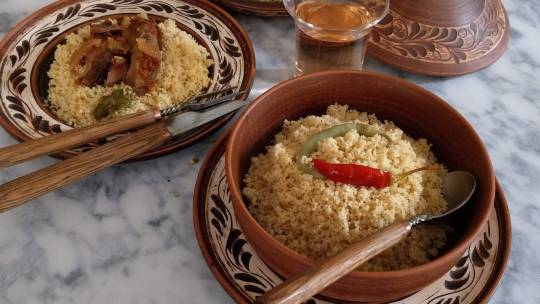
Meat and recipe both came from Irish on-line source James Whelan.
I think this would work well in a slow-cooker.
BTW, on-line recipes like this can change with the seasons, so I'm adding it below the cut.
*****
For a more fragrant and pungent dish, the lamb can be covered in clingfilm and marinated in the fridge for up to 24 hours to allow the spices to penetrate the meat. The accompanying couscous can be jazzed up with pistachio nuts and dried fruits.
Moroccan Style Braised Lamb Shanks – Printer Friendly Download
Ingredients
4 lamb shanks, well trimmed
1 tablesp. paprika
1 teasp. each ground coriander, cumin, cinnamon and turmeric
Sea salt and cracked black pepper
2 tablesp. olive oil
1 large onion, roughly chopped
2 garlic cloves, chopped
2½ cm piece peeled fresh root ginger, chopped
450ml chicken or lamb stock
2 x 400g cans chopped tomatoes
1 tablesp. clear honey
Squeeze of lemon juice
Serve with a bowl of couscous
Serves: 4
To Cook
Cooking Time: 2¾ hours
Preheat the oven to Gas Mark 3, 160ºC (325ºF).
Heat a large frying pan.
Mix together the paprika, coriander, cumin, cinnamon, turmeric and one teaspoon of pepper in a large bowl.
Add the lamb shanks and using your hands rub in the spices.
Add a little of the olive oil to the heated pan and quickly brown off two of the spiced lamb shanks.
Transfer to a casserole dish with a lid and repeat with the remaining lamb shanks.
Meanwhile, place the onion, garlic and ginger in a food processor or mini-blender and pulse until finely minced.
Add another tablespoon of the olive oil to the pan, then add the onion mixture and sauté for 3-4 minutes until well softened and coloured from the spices left in the bottom of the frying pan.
Pour a little of the stock into the pan, stirring to combine and then tip over the lamb shanks.
Add the remaining stock with the tomatoes and honey, stirring gently until evenly combined.
Cover with the lid and cook for 2-2½ hours until the lamb shanks are meltingly tender and the meat is ready to fall off the bone.
Add a squeeze of lemon juice and season to taste.
We hope you enjoyed reading this post by Pat Whelan of James Whelan Butchers. Pat is a 5th generation butcher, cook book author and the director of James Whelan Butchers with shops in Clonmel, the Avoca Handweavers Rathcoole and Kilmacanogue, Dunnes Stores Cornelscourt, Rathmines and Swords in Dublin.
383 notes
·
View notes
Text
More fun with Lazy Researcher Telephone leading to the circulation of completely false information:
A 1764 court document (re-discovered by Gwendolin Mildo Hall) is currently believed to be the oldest reference to gumbo (as in the okra-and-meat stew, not okra itself). Shane K. Bernard said in 2011 that Hall had mentioned the document in a lecture, but she presumably didn't give detailed information, since he ended up e-mailing her to get the actual citation.
She pointed him to the Louisiana Historical Center, who sent him a copy of the document in question, which he posted a small snippet from. You don't have to contact the LHC to get the full document--it's been digitised (look towards the bottom right of page 4/21 for the reference to "un gombeau"), along with other documents pertaining to the same court case.
That lecture wasn't the only place where Hall had elaborated. Earlier, in 2005, Hall had published Slavery and African Ethnicities in the Americas: Restoring the Links, which contains a passage talking about Comba / Julia, the woman whose testimony contains the reference to "gombeau" (Bernard didn't mention this book). She describes what led to the 1764 court proceedings--fugitive slave Louis dit Foy "had organized a cooperative network among slaves, runaways, thieves, seamstresses, and street vendors" and the group 'stole' food for their social gatherings. Hall says of two women who were members of this group:
Comba and Louison, both Mandingo women in their fifties, were vendors selling cakes and other goods along the streets of New Orleans. They maintained an active social life, organized feasts where they ate and drank very well, cooked gumbo filé and rice, roasted turkeys and chickens, barbecued pigs and fish, smoked tobacco and drank rum. (Slavery and African Ethnicities, University of North Carolina Press, 2005, p. 99)
Hall cites as the source of her information "Records of the Superior Council of Louisiana, May 6 and May 10, 1768, contract between Evan Jones of Pensacola and Durand Brothers; declaration by Captain Peter Hill. Records of the Superior Council of Louisiana, 1768.05.10.02, Louisiana Historical Center, New Orleans" (FN 36, p. 187).
It is unclear from Hall's text whether "gumbo filé" is specifically named or described in these court documents (if it is, I have not yet found it--and it also seems strange that Hall wouldn't have pointed Bernard to that location), or what other reason Hall might have for asserting this. It may just be an assumption of her's. As written, it sounds like the "gombeau" mentioned isn't even sure to be modern "gumbo" (as Bernard points out, a dish of stewed okra with butter was called "gumbo" at this time and later). Hall's research interests do not centre around food.
From this point, someone must have found Bernard's reference to this court document, and also found the paraphrasing of the case proceedings in Hall's book. They must have mentioned the court document without quoting or citing it; and they must have quoted the passage from Hall that I quoted above, also without citing it, and made it seem as though the Hall passage was in the court document. Whoever this unforgiveable bumbling can be traced back to, whether him or someone else, Lolis Eric Elie at least recreated it. In 2005, he wrote in a letter to the New York Times:
The first known printed reference to gumbo was made in reference to food eaten not by French immigrants, but by African maroons who had escaped slavery in Louisiana. This passage, from a 1764 court document, was uncovered by Gwendolyn Midlo Hall, author of "Africans in Colonial Louisiana":
"Comba and Louison, both Mandingo women in their 50's [sic], were vendors selling cakes and other goods along the streets of New Orleans. They maintained an active social life, organized feasts where they ate and drank very well, cooked gumbo filé and rice, roasted turkeys and chickens, barbecued pigs and fish, smoked tobacco and drank rum."
And then someone must have read that letter and believed Elie that that paragraph of Hall's was in the 1764 court document (it doesn't exactly sound like the kind of language I would expect to have been written as a summary of court proceedings in 1764, but I suppose they didn't think to check...)
So now, as a result of all of this jumbling of assumptions with evidence, and unwillingness to track down actual primary sources (even when someone has already digitised and quoted and translated them for you!), you have people confidently asserting that "gumbo filé" was specifically mentioned for the first time in 1764.
For example, Jonathan Olivier, writing for The Bitter Southerner in 2021, writes:
Looking back further at the historical record, there is more evidence of distinctions between types of gumbo. The first recorded mention of gumbo is from a 1764 court document involving escaped enslaved Africans, found by historian Gwendolyn Midlo Hall [...].
“Comba and Louison, both Mandingo women in their 50s [sic], were vendors selling cakes and other goods along the streets of New Orleans. They maintained an active social life, organized feasts where they ate and drank very well, cooked gumbo filé and rice, roasted turkeys and chickens, barbecued pigs and fish, smoked tobacco and drank rum.”
The entire term “gumbo filé” is mentioned, a deliberate effort to highlight a soup thickened with powdered sassafras, not okra.
Yes, Olivier, the term "gumbo filé" was mentioned... by Gwendolin Hall in 2005, not by Comba in 1764! What a mess! What an absolute disgrace of a mess. Lmao.
25 notes
·
View notes
Text
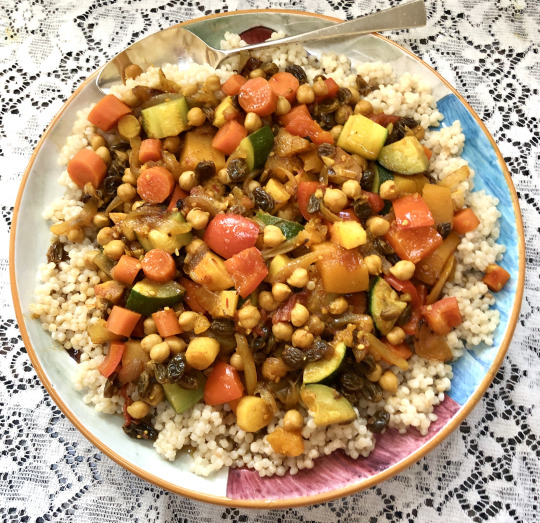
Israeli Couscous with Seven Vegetables
Follow me on Instagram @RonnieVFein
It isn’t my Ashkenazi family tradition, but among North African Jews, and particularly Moroccan Jews, there’s a fabulous dish served on Rosh Hashanah: Couscous with Seven Vegetables.
I’ve cooked versions of this dish several times mostly because it sounded so delicious and also because I am always on the lookout for a good, festive and filling vegetarian entree.
This one satisfies in every way possible.
This is the recipe we like best: I used Israeli couscous rather than the traditional tiny grains of Moroccan couscous because my family likes it better. Also, I used Harissa paste (because I always have some) but you can substitute red pepper flakes or a pinch or two of cayenne pepper (or leave it out if you don’t want any pepper). My husband said he would like more raisins. Up to you…..
ISRAELI COUSCOUS WITH SEVEN VEGETABLES
2 tablespoons olive oil
1 large onion (preferably a sweet variety such as Vidalia), sliced
1 teaspoon finely chopped fresh ginger
1 clove garlic, finely chopped
4 carrots, peeled and cut into 1/2-inch slices
2 medium tomatoes, cut into chunks
1 parsnip, peeled and cut in 1/2-inch slices
1 cup cut up bite sized butternut squash
1/2 teaspoon harissa paste
1/2 teaspoon ground turmeric
1/2 teaspoon ground cinnamon
2-1/2 cups vegetable stock
1/2 large red bell pepper, cut into bite sized chunks
1 small zucchini, cut into bite sized chunks
1 cup raisins
1 cup canned chickpeas, rinsed and drained
Salt to taste
1-1/2 cups Israeli couscous
Heat the olive oil in saucepan over medium heat. Add the onion and cook, stirring often, for about 5-6 minutes or until softened and beginning to brown. Add the ginger and garlic and cook for 1-2 minutes. Add the carrots, tomatoes, parsnip and squash and stir the ingredients. Stir in the harissa, turmeric and cinnamon. Add the stock, bring to a boil, reduce the heat to medium low and cook for about 15 minutes. Add the bell pepper, zucchini, raisins and chickpeas. Cook for about 10 minutes more, or until vegetables are tender. Add salt to taste. Cook the couscous according to the manufacturer’s directions. Spoon the couscous on large serving platter. Spoon the vegetables and pan fluids over the couscous.
Makes 4 dinner servings, 8 side dish ervings
#israeli couscous with 7 vegetables#couscous with vegetables#chick peas#rosh hashanah#rosh hashanah 2023#Israeli couscous#vegetarian entree#North African food#Moroccan food#Jewish holidays#vegetable stew
17 notes
·
View notes
Text
Lemon and Apricot Lamb Tagine

This fragrant and spicy Lemon and Apricot Lamb Tagine elevates your leftover Easter roast into a more-ish and comforting North African stew, warming you up from these April showers! Happy Thursday!
Ingredients (serves 3 to 4):
2 tablespoons olive oil
1 1/2 teaspoon Ras-el-Hanout
1/2 teaspoon dried thyme
1/4 teaspoon cumin seeds
1/4 teaspoon ground chilli
6 plump cardamom seeds
1/2 large onion
1 garlic clove, minced
1 large lemon
1/2 cup dried apricots
1/3 cup almonds
1/2 teaspoon coarse sea salt
1/2 teaspoon freshly cracked black pepper
Leftover Herb Lamb Roast with plenty of meat on the bone, along with 1 cup of its Roasting Juices, congealed
3 cups water
2 heaped tablespoons good pure honey
1 teaspoon demerara sugar
In a large Dutch oven, heat olive oil over medium-high heat. Add Ras-el-Hanout, dried thyme, cumin seeds and ground chilli, and fry, 1 minute.
Crush cardamom pods, and add them to the Dutch oven. Fry, 1 minute more.
Peel and finely chop onion, and stir into the Dutch oven, coating in spices. Fry, a couple of minutes.
Add minced garlic and cook, 1 minute.
Cut lemon into quarters, and cut each quarter in half. Add lemon pieces to the Dutch oven, along with dried apricots and almonds. Cook, 3 minutes. Season with coarse sea salt and black pepper.
Add leftover Herb Lamb Roast to the Dutch oven, and brown briefly, on all sides. Then, stir in its Roasting Juices, until melted. Add water, and bring to the boil.
Once boiling, cover with the lid, and simmer, one hour, until the Lamb meat fall off the bone. Stir in honey and demerara sugar until melted.
Serve Lemon and Apricot Lamb Tagine hot, onto Lemon Semolina.
#Recipe#Food#Lemon and Apricot Lamb Tagine#Lemon and Apricot Lamb Tagine recipe#Lamb Tagine#Lamb Tagine recipe#Lamb#Lamb Roast#Roast Lamb#Lamb Veal and Game#Olive Oil#Ras-el-Hanout#Dried Thyme#Ground Chilli#Cardamom#Cardamom Seeds#Onion#Garlic#Lemon#Dried Apricots#Apricots#Almonds#Coarse Sea Salt#Black Pepper#Black Peppercorns#Honey#Demerara Sugar#Stew#Stew recipe#Soup and Stew
5 notes
·
View notes
Text
“For American working women, World War I brought an unprecedented boon in employment opportunities. As men enlisted in the armed forces or were drafted, they left behind jobs in industry and business that had never previously been open to women. The departure of the regular workers, combined with the enormous Allied demand for munitions and war support materials, helped to produce a labor vacuum that women rushed to fill. Tens of thousands of new jobs opened up. Iron and steel mills, munitions factories, chemical and electrical industries all sought women workers.
Women happily shifted from traditional women’s jobs in domestic service and unskilled factory labor to the more demanding and better paying wartime jobs. A number of women were joining the paid labor force for the first time, but most of the growth in women’s work took place among those who were already working for wages. At one point during the war, women comprised 20 percent or more of all workers manufacturing airplanes, electrical machinery, leather and rubber goods, food, and printed materials. Women in industry ran presses and drills, lathes, welding tools, and milling machines; a few even operated cranes.
…For many African-Americans, the war brought geographical changes as well as changes in employment. During the Great Migration of 1915 to 1920, some 500,000 Southern black men and women left for Northern cities, where industrial labor shortages caused by the call-up of white men had created unheard-of opportunities. As white women replaced white men in industry and business, black women were able to move into jobs that the white women had vacated. The wages were especially attractive: a cook or laundress could earn in a day what she had in a week in the South; in industry she could earn $3 a day, compared to 50 cents for picking cotton. Domestic service paid twice what it did in the South. Railroads hired black women as cleaners and yard workers and paid government-regulated wages.
Despite these advantages, the persistence of racism in the North meant that many black women were paid 10 to 60 cents less than white women doing similar work and that they were always assigned to the hottest, dirtiest, and most disagreeable tasks available. Although African-American women increased their participation in Northern industry by 100 percent, they remained less than 7 percent of the women’s industrial labor force.
…In the course of the 1916 election campaign both the Republican and Democratic parties had endorsed woman suffrage but left the decision up to the individual states. Once safely reelected, Wilson let the subject of woman suffrage drop. During his first address to Congress after the election, Wilson pretended to ignore a large banner unfurled from the gallery by Alice Paul and members of the National Woman’s Party, the radical faction of the suffrage movement. The banner read, “Mr. President, What Will You Do for Woman Suffrage?” A few weeks later, in early 1917, the National Woman’s Party began systematically to picket the White House, and on Wilson’s inaugural day a thousand women marched solemnly around and around outside the heavy iron fence.
No one, including the President, would be able to ignore woman suffrage much longer. The campaign was receiving front page coverage in newspapers all over the country; it was featured prominently in popular magazines; the national environment was growing daily more supportive; and 4 million women in 11 states could now vote. If they could add one large Eastern state, women would have enough political power to push toward the amendment and to unseat congressmen and senators who refused to convert to the cause. With 2 million members, NAWSA itself was now the largest women’s voluntary organization in the country. As their cause made increasingly visible progress and their work intensified, suffragists grew more and more exhilarated.
…In June 1919, after a string of negative votes, the Senate finally approved the suffrage measure. Scarcely pausing for breath, suffragists fanned out across the country to help secure the needed ratification by three-quarters of the states. In less than a year, 35 of the necessary 36 states had ratified the amendment. National attention then focused on Tennessee, the only remaining state in which anti-suffrage was not so firmly entrenched as to make ratification impossible. Still, the opposition was fierce, and representatives of the anti-suffrage interests poured into the state capital of Nashville, alternatively threatening the legislators and plying them with liquor.
On the last day of the special session, the vote came down to a single undecided representative, 24-year-old Harry Burn, the youngest member of the legislature. Just hours before the vote, Burn had received a letter from his mother, a suffrage supporter, urging him to “be a good boy and help Mrs. Catt put ‘Rat’ in Ratification.” Burn voted “Yes,” and the amendment passed. A few days later, on August 26, 1920, the Secretary of State issued a formal proclamation declaring the elective franchise to be the right of every adult woman citizen of the United States. It had been 72 years, one month, and one week since the meeting in Seneca Falls, New York, on July 19, 1848, when American women had first convened to demand their “sacred right” to vote.”
- Karen Manners Smith, “Women in War and Peace.” in New Paths to Power: American Women, 1890-1920
2 notes
·
View notes
Text
Sweet Potato Pie

Below is an article about the dessert known as Sweet Potato Pie:
SWEET POTATO PIE
When it comes to holiday desserts - especially those for Halloween, Thanksgiving or Christmas, many people tend to bring up the old favorite, Pumpkin Pie. But there is another pie that is also popular in the United States. It is called the Sweet Potato Pie.
Creamy vegetable pies date as far back as the Medieval era in Europe. But like the Pumpkin Pie, Sweet Potato Pie can trace its origin to the early Colonial era, especially in the southern colonies. And like Pumpkin Pie, Sweet Potato Pie can be traced to Native American cuisine. The sweet potato - called a "yam" by some (although it is not one) - is native to the tropical regions of the Americas. Namely the Peruvian forests. Spanish traders who had arrived in Peru, eventually introduced the vegetable worldwide - especially in North America and Europe.
The sweet potato became very popular in Europe, especially in Britain. Cookbooks like 1747's "The Art of Cookery Made Plain and Easy" included recipes for tarts, other pastries and puddings that utilized sweet potatoes. The vegetable eventually attracted the attention of wealthy Southern plantation owners and eventually tasked their enslaved cooks to prepare or create sweet potato dishes.
Originally, the African or African-American slaves were accustomed to the textures and flavors of their native West African root tubers such as the starchy yam and cassava. They did not immediately embrace the sweet potato when it was first introduced. In the end, they regarded the sweet potato as a substitute for the yam and like their enslavers, embraced it. One of the dishes created by enslaved cooks during the Colonial period proved to be the Sweet Potato Pie. This especially tend to be the case in the American South. Since pumpkins grew in abundance in the Northeastern colonies - later states - the Sweet Potato Pie had never reached the same level of popularity in that region, like it did in the South.
Sweet Potato Pie was basically prepared as a dessert in an open pie shell. Its filling consisted of mashed sweet potatoes, evaporated milk, sugar, nutmeg, cinnamon, nutmeg and eggs. Alternate ingredients include vanilla or lemon extract. The custard filling may vary from light to dense, depending on the recipe's ratio of sweet potato, milk and eggs. As I had hinted earlier, Southerners and African-Americans specifically, usually ate Sweet Potato Pies during the American holiday season, especially on Thanksgiving and Christmas, as a dessert.
Below is a recipe for "Sweet Potato Pie" from Rosie Mayes' I Heart Recipes website:
"Sweet Potato Pie"
Ingredients:
Pie Crust
*Cold butter and butter-flavored shortening
*Cold water
*All-purpose flour
*Salt
*Vanilla extract
*White granulated sugar
(Note: You can also purchase a ready-made pie crust as a substitute)
Pie Filling
*Sweet potatoes or yams
*Evaporated milk or half-and-half milk
*Vanilla extract or Bourbon Vanilla extract
*Cinnamon
*Nutmeg
*Ginger or lemon extract
* Hand-crafted yams spice mix from Rosamae Seasonings
*Two large eggs
*White granulated sugar
Preparation:
Pie Crust
*Combine flour, salt, sugar, vanilla, butter, butter-flavored shortening, and ice-cold water in a stand mixer.
*Mix until well combined into a dough.
*You’ll want to wrap the dough in plastic wrap and allow it to chill in the fridge until you’re ready to roll it out.
*You could also use a food processor to make the dough.
Pie Filling - Boil Sweet Potatoes
*Wash and peel the skins of the sweet potatoes and chop them up into about 1-inch cubes.
*Put the sweet potatoes in a pot with enough water to cover them completely (about 4-6 cups).
*Boil the sweet potatoes until they are fork-tender, about 15-20 minutes.
Pie Filling - Bake Sweet Potatoes
*Preheat your oven to 350 degrees Fahrenheit.
*Pierce the sweet potatoes with a fork, then place on a baking sheet and cook—with the skin on—until fork-tender. The time really depends on how big they are, but it should take about 35 minutes.
*Scoop out the insides of the sweet potatoes into a large bowl, and allow them to cool completely.
Preparation (continued)
*In a large bowl or stand mixer, whip the sweet potatoes until they’re fluffy and creamy—no lumps! You can either use a hand mixer (electric mixer) or the whisk attachment of your stand mixer.
*Next, add the rest of the sweet potato pie filling ingredients—eggs (make sure they’re at room temperature), sugar, spices, vanilla, evaporated milk, and butter (also at room temperature). Mix these ingredients until well combined. You want your pie filling to be almost fluffy—that gives this sweet potato pie its iconic texture.
*Next, roll out the cold pie dough. For best results, you should use a 9-inch pie plate. I do blind-bake my pie crust at 350 degrees for just 10 minutes before adding the filling.
*Finally, add the sweet potato pie filling. Smooth it in that crust, then bake for 45-50 minutes. It will look weird and puffy when it comes out but allow it to cool, and it’ll settle.
*Let the sweet potato pie cool for at least 30 minutes, up to 2-4 hours, until it’s at room temperature. This will allow the pie filling to set completely, so it’s the perfect fluffy texture.
#food#food history#history#medieval europe#spanish empire#british empire#colonial america#u.s. slavery#sweet potato pie#i heart recipes#rosie mayes#holidays#holiday cooking#thanksgiving#christmas
2 notes
·
View notes
Text
15 questions for 15 mutuals
I was tagged by @ngelwaves Thank you so much bby 🫶🏼
1. are you named after anyone?
Yes and no? My full name is Meissa. It is an arabic name. It is pronounced like Missa, my mom wanted to name me after my grandma but she refused lol. So, i was named smth close to her name. Friends and fam call me Mei tho.
2. when was the last time you cried?
Last night 💀
3. do you have kids?
No. I love babies sm!! But i dont like kids… AM I MAKING SENSE?? it’s like they be so cute before they start talking and walking. Maybe that will change if i ever have my own.
4. do you use sarcasm a lot?
I DO. Only with close ones tho, not all people appreciate sarcasm.
5. what sports do you play/have you played?
I hate sports tbh. It’s enjoyable to watch but not to play lol. I did play some though in HS like basketball and volleyball. Right now i just enjoy working out.
6. what's the first thing you notice about other people?
Their hand gestures when they are talking, teeth, and their style. I firmly believe that the way people style themselves is them showing their own creativity. I love to observe the little details they add to their fits or even makeup and hair. Also shoes!! I love people who take care of their shoes. Their scents too i believe! In my country we salute each other by kissing the cheeks twice lol. So, it is hard to not notice how they smell like.
7. eye color?
Dark brown.
8. scary movies or happy endings?
HORROE MOVIES ALL THE WAY 🙌🏼 i think i’ve watched every scary movie there is out there, even those from 80s and 90s. I’m a cinephile. If anyone here uses Letterboxd, give me your @ or follow me, mine is sunflxwxr.
9. any special talents?
I’m a painter, i do realism. ( should i post my portraits here ?? )
10. where were you born?
Algiers.
11. what are your hobbies?
I love reading, but fiction mostly, and painting, sketching, playing video games, cooking too hehe. Also learning new languages, i think being a north African gave me the benefit to pick up languages fast and imitate any accent.
12. do you have any pets?
YES. I have a Russian blue cat, his name is Mishy, he is 1 year old 🥺🫶🏼 and a siamese kitten, his name is Mike, he joined the fam just recently.
13. how tall are you?
1.70
14. fave subject in school?
English and History. I actually majored in English literature and civilization. French as well ( it is the 2nd spoken language after Arabic here )
15. dream job?
I always wanted to become a professional painter, but welp. I am a teacher but it’s not really my dream job. I also want to have my own clothing brand one day !! I adore clothes and fashion.
Tagging : i dont know who to tag so i’m tagging everyone who gets to read this 🫶🏼
4 notes
·
View notes
Text
Barbecue sauce (also abbreviated as BBQ sauce) is a sauce used as a marinade, basting, condiment, or topping for meat cooked in the barbecue cooking style, including pork or beef ribs and chicken. It is a ubiquitous condiment in the Southern United States and is used on many other foods as well.[1]
Ingredients vary, but most include vinegar or tomato paste (or a combination) as a base, as well as liquid smoke, onion powder, spices such as mustard and black pepper, and sweeteners such as sugar or molasses
Some place the origin of barbecue sauce at the formation of the first American colonies in the 17th century.[2] References to the sauce start occurring in both English and French literature over the next two hundred years. South Carolina mustard sauce, a type of barbecue sauce, can be traced to German settlers in the 18th century.[3]
Early homemade barbecue sauces were made with vinegar, salt, and pepper. Sugar, ketchup, and Worcestershire sauce started to be used in the 1920s, but after World War II, the quantity of sugar and the number of ingredients increased dramatically.[4]
The Georgia Barbecue Sauce Company of Atlanta advertised an early commercially produced barbecue sauce in 1909.[5] Heinz was the first major company to sell bottled barbecue sauce in 1940. Soon afterward, General Foods introduced "Open Pit." Kraft Foods only entered the market in around 1960, but with heavy advertising, succeeded in becoming the market leader.[4] Kraft also started making cooking oils with bags of spice attached, supplying another market entrance of barbecue sauce.[6]
Different geographical regions have allegiances to their particular styles and variations of barbecue sauce.
East Carolina – Most American barbecue sauces can trace their roots to a sauce common in the eastern regions of North Carolina and South Carolina.[3] The simplest and the earliest, it was popularized by enslaved Africans who also advanced the development of American barbecue, and originally was made with vinegar, ground black pepper, and hot chili pepper flakes. It is used as a "mopping" sauce to baste the meat while it is cooking and as a dipping sauce when it is served. "Thin, spicy, and vinegar based," it penetrates the meat and cuts the fats in the mouth, with a noticeably tarter flavor than most other barbecue sauces.[7]
Western Carolina – In Lexington and the Piedmont areas of western North Carolina, the sauce is often called a dip. It is similar to the East Carolina Sauce with the addition of tomato paste, tomato sauce, or ketchup.[8]
South Carolina mustard sauce – Part of South Carolina is known for its yellow barbecue sauces made primarily of yellow mustard, vinegar, sugar and spices. This sauce is most common in a belt from Columbia to Charleston.
Memphis – Similar to the Western Carolina style, but using molasses as a sweetener and with additional spices. It is usually served as a dipping sauce, as Memphis-style barbecue is typically a dry rub.[9]
Kansas City – Thick, reddish-brown, tomato-based, and made with sugar, vinegar, and spices. It evolved from the Western Carolina and Memphis style sauces but is thicker and sweeter and does not penetrate the meat as much as it sits on the surface. Typical commercial barbecue sauce is based on the Kansas City style.[9]
Texas – In some of the older, more traditional restaurants, the sauces are heavily seasoned with cumin, chili peppers or chili powder, black pepper, and fresh onion, while using less tomato and sugar. They are medium thick and often resemble a thin tomato soup.[10] They penetrate the meat easily rather than sit on top. Bottled barbecue sauces from Texas are often different from those used in the same restaurants because they do not contain meat drippings.[11]
Alabama white sauce – North Alabama is known for its distinctive white sauce, a mayonnaise-based sauce that also includes apple cider vinegar, sugar, salt, and black pepper, which is used predominantly on chicken and pork.[12]
2 notes
·
View notes
Text
Some kinda north african inspired dish
Meat of your choosing; I used some beef strips meant for stirfry
Ras el hanout
Chickpeas
Dried cilantro
Dried parsley
Sesame seeds
2-4 tomatoes, depending on size; I used half a can of san marzano tomatoes
2 bay leaves
6 cloves garlic, minced
1 onion, diced
In some olive oil, begin cooking onion, garlic and bay leaves. Cook until soft. Add meat and spices and cook until meat is done. Blend tomatoes and add to pan once meat is cooked. Combine and let sauce reduce a little before adding chickpeas. Cook until chickpeas are cooked, and you're done.
9 notes
·
View notes
Text
A few years ago I visited friends from Washington D.C. who had relocated to Morocco. They live in Rabat, Morocco’s capital city, where they had a housekeeper who was also a good and generous cook. Although Fatima spoke only Arabic and French while I speak English and Spanish, we both understood the language of food. I would sit at the kitchen table or stand by her, taking notes as she worked her magic with fresh ingredients from the local market.
True to Moroccan cuisine, Fatima was skilled at cooking in a tagine, that wondrous North African earthenware pot with the conical lid that creates tender, flavorful dishes of the same name. Tagines always involve lots of vegetables, and sometimes meat. The shape of the tight-fitting lid traps the rising steam as the food cooks, which condenses into drops of liquid flavor.
Like most of you, I don’t have an actual tagine. But after returning from Morocco, I discovered that a Dutch oven or heavy-bottomed pot can work as a stand-in, provided it has a tight-fitting lid. Many enameled Dutch oven lids have condensation rings, which are helpful. Try not to lift the lid as it will break the steam-condensation process. This recipe is inspired by Fatima’s cooking. Imitating the tagine method, vegetables are added in layers, with the ones needing the longest cooking time at the bottom.This dish is perfect for Shabbat, being both special and comforting. Serve it the traditional way with steamed couscous and pretend for a little while that you’re far away, enjoying the delights of Morocco.
Cooking notes:
Usually only about a cup of broth or water is added to the tagine, but I’ve doubled the liquid as a bit of insurance against burning the bottom. If you want it to be more like a stew, add 2 additional cups of broth or water.
Be sure to leave a couple inches between the top of the vegetables and the lid of your pot.
There’s a lot of flexibility in the ingredients. No carrots in the house? No worries. Got green beans or eggplant you want to use up? Add the eggplant, cut in 1/2-inch cubes, before the zucchini, and the whole or cut green beans after. Turnips and other squashes also work well.
I have included a recipe to make your own simplified Ras el Hanout, a spice blend so important in North African cuisines that its means “head of market.” You can also buy it pre-made from Middle Eastern markets, specialty vendors like NY Shuk or even on Amazon. Keep in mind that, like all store-bought spice mixes, the combinations, taste and color can vary.
This spice mix will freeze well for up to two months.
Ingredients
For the Moroccan spice blend:
1 Tbsp paprika
1 Tbsp cumin
2 tsp ground ginger
1 tsp turmeric
<1 tsp cinnamon
1 tsp coriander
1/2 tsp allspice
1/4 tsp cloves
For the tagine:
2 Tbsp olive oil, divided
1 large onion, diced
3 large cloves garlic, minced
2 Tbsp Moroccan spice mixture (below) or store-bought Ras el Hanout, divided
1 butternut squash or pumpkin (2-2 1/2 pounds), peeled, seeded and cut into 1-inch cubes (3-4 cups)
1 can (15 ounces) chickpeas, drained with chickpeas and liquid (aquafaba) reserved separately
peel from 1 small preserved lemon, diced or cut into very thin strips, or 2 tsp grated fresh lemon zest, divided
2 medium sweet or yellow potatoes (1-1 1/2 pounds), unpeeled and cut into 1/2-inch slices
2 medium carrots, cut 1/2 inch wide
2 medium zucchinis, cut into 1/2-inch half moons
1 large tomato
1/2 small green cabbage, cut into 6-8 thin wedges
2 cups hot vegetable stock or water
1/2-1 tsp salt
1 cup green or black olives (optional)
chopped cilantro or parsley (optional)
Directions
To make the spice blend: Whisk all the spices together in a bowl until well blended. Store mix in an airtight glass or stainless-steel container in a cool, dry place.
To make the tagine: In a heavy-bottomed 6- or 7-quart pot or Dutch oven with a tight-fitting lid, heat 1 Tbsp oil over medium heat. Add onions with a pinch of salt and sauté, stirring occasionally, for about 10 minutes, until tender but not browned. Add garlic and 1 Tbsp of the spice mixture. Cook, stirring, for about 2 minutes, until aromatic.
Add the liquid from the chickpeas (aquafaba) and the squash cubes to the pot, and stir.
Turn the heat as low as possible while you layer the vegetables, building a domed shape as you go. Sprinkle about a third of the preserved lemon or lemon zest over the squash or pumpkin, then cover with potato slices. Add a layer of carrots, a third more lemon. Layer the zucchini on top. Lean wedges of cabbage against the sides of the vegetable mound.
In a small bowl, whisk together the hot broth or water with the remaining 1 Tbsp each of oil and spice mixture. Pour over the vegetables. Cover the pot and turn the heat up to medium.
While the tagine heats, use a small knife to peel the skin from the bottom of the tomato. Holding onto the top or stem, grate the tomato flesh on the large holes of a box grater into a dish, leaving discarding the skin. Add the grated tomato and juices to the pot, on top of the zucchini.
As soon as the tagine starts to simmer, reduce heat to low and let cook undisturbed until the vegetables are almost tender, about 25-30 minutes.
Add the chickpeas, olives and remaining lemon. Add a little more stock or hot water if the pot looks dry. Cover and continue to cook for another 10-15 minutes.
Serve in the pot, or the vegetables can be carefully moved and arranged on a large serving platter, taking care with each layer of vegetables and serving on top of couscous or rice. Garnished generously with chopped cilantro or parsley.
5 notes
·
View notes
Photo

Five of Coins. Art by Kim Thompson, from Divine Your Dinner.
OVERCOMING SCARCITY
Resource management is tough work, so why do we make it harder for ourselves? Obsessing about what we don’t have is the real great American pastime (sorry, baseball!). The problem, besides how terrible it feels, is that it takes up a lot of energy that could be spent focused on building with what we have and identifying our true needs. Slay the scarcity-mentality vampire with—what else? Garlic.
Garlic gets a lotta play, but this is truly its time to shine. In addition to repelling vampires, it is used in protection, driving away evil, and energy clearing spells in many folk medicine and magickal traditions. There is a TON of it in this recipe. Be gone, energy suckers!
MAGICKAL INGREDIENTS: GARLIC (SEE ALLIUMS), LEMON, MUSHROOMS, RADISH, ENDIVE (SEE CHICORIES), RADICCHIO (SEE CHICORIES), CELERY, FENNEL, POTATOES
BAGNA CAUDA “CRUDITÉS” FONDUE
SNACK—SERVES 8 TO 10
Bagna cauda is a traditional dish from Piedmont, Italy, and if you’ve never tried it, now is your chance. Technically a dip, it’s really more like an oil fondue. You’ll also add some preserved lemons, which are for sure not a traditional Piedmontese ingredient (they are typically found in North African cuisine), but they add wonderful sour notes to amplify the flavors of the garlic oil and anchovy.
Serve the bagna cauda with some crusty bread and an assortment of fresh and cooked vegetables (we call them “crudités” for ease), and everyone can either use their hands or a skewer to dip the veggies into the oil. If you have a fondue pot, now would be a fabulous time to bust it out.
BAGNA CAUDA
1 cup extra-virgin olive oil
2 whole heads garlic, roughly chopped
1 (3.17-ounce) jar anchovies in oil
½ preserved lemon, roughly chopped
ACCOMPANIMENTS
3 pounds assorted crudités of your choosing
1 large loaf crusty bread, cut into ¼-inch slices, for serving
1. MAKE THE BAGNA CAUDA: In a large saucepan, combine the olive oil, garlic, anchovies, and lemon and heat over low heat for 30 minutes, until fragrant. Using a spoon or potato masher, mash the mixture into a paste. Cook, mashing occasionally, until the anchovies and garlic have basically melted into the oil and it is deeply fragrant, 2 to 3 hours longer.
HOT TIP: IF THE OIL IS TOO HOT, IT WILL COOK EVERYTHING TOO FAST AND THE RESULT WON’T BE AS TASTY. THE OIL SHOULD JUST BARELY BUBBLE AS YOU SLOWLY DISSOLVE EVERYTHING INTO IT.
2. Meanwhile, prepare the crudités. Choose one to two each of raw, broiled, and boiled veggies. Our go-tos are raw endive and radishes, broiled trumpet mushrooms and shishito peppers, boiled potatoes, and blanched broccolini.
3. Arrange the crudités on a large platter with the warm bagna cauda in the center and serve with bread.
4. FOR THE RAW VEGETABLES: Wash them well, remove the stems, and separate any leaves. Submerge in ice water for a few minutes to make them extra crisp.
5. FOR THE BROILED VEGETABLES: Set the broiler to high. Working with one vegetable at a time toss each with olive oil and kosher salt and arrange on a sheet pan, being sure not to overcrowd the pan. Broil until charred, about 5 minutes.
6. FOR THE BOILED POTATOES: Add the potatoes to a pot of water and bring to a boil over medium-high heat. Boil until tender, about 25 minutes.
7. To blanch asparagus, Romanesco, broccolini, and cauliflower, bring a pot of water to a boil over medium-high heat. Once boiling, add each vegetable separately and cook until just softened, about 3 minutes.
Remove them from the pot using tongs, add to a large bowl, and immediately run under cold water.
SUGGESTED “CRUDITÉS”
RAW
* greens (like kale, chard, mustard, radicchio, endive, or Little Gem lettuce)
* 1 small bunch radishes, whole or halved
* celery ribs, cut into bite-size pieces
BROILED
* carrots, cut into bite-size pieces
* turnips, cut into bite-size pieces
* fennel bulb, cut into bite-size pieces
* large mushrooms, whole or halved
* zucchini, cut into bite-size pieces
* whole shishito peppers
BOILED OR BLANCHED
* fingerling potatoes, halved
* whole, trimmed asparagus
* Romanesco, broken into florets
* whole, trimmed broccolini
* cauliflower, broken into florets
7 notes
·
View notes
Photo

I bought some minced lamb last week with an eye to BBQ during incoming hot weather, but the weather turned out so hot enough that standing over glowing charcoal didn’t appeal. In addition the horseflies were especially rambunctious; I swatted three off me in the couple of minutes I was checking the outdoor temperature and deciding Nope, too hot.
Eating food outside is fine, being fed on outside, not so good.
*****
So the other night I used it to throw together this Lamb Kofte Tajine, a vaguely North African version of meatballs in tomato sauce. “Throw together” is accurate, I winged it without consulting any books or recipes and even the cooking procedure is highly inauthentic; far too fast for one thing. It worked, though, and was very good.
(The last time was an Indian-influenced treatment: more slowly cooked, just as vague, just as good.)
Putting already-minced meat in a food processor may seem excessive; however there’s a good reason when making kofte / kofta / kufteh (etc.). These are North African / Middle Eastern / Indian meatballs, the original word means “pounded”, and processing recreates a very fine pestle-and-mortar texture which holds together without assistance from egg or breadcrumbs.
*****
A vegetarian version could simply replace the meat meatballs with lentil ones; there are plenty of recipes online including Moroccan-style. I also think this would work splendidly using falafel; they might not keep the crunch of freshly fried ones, but they’ll have the same crust and mouthfeel as the grilled kofte.
This was even good cold, not that there was much left. I plan to remake the basic sauce then boost it with harissa (Tunisian chilli relish) or zhoug (Yemeni coriander relish) to see if it makes as good a dip as my imagination suggests. That imagination is also suggesting not just home-made pita bread to dip in it, but pita cut into strips and fried in olive oil so it stays crunchy.
Yum...
*****
Anyway, here’s how to make the sorta-kinda-tajine.
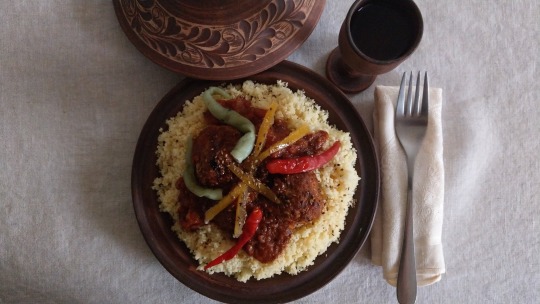
Sauce
1 onion, chopped finely
2-4 cloves of garlic, chopped finely
50 ml olive oil
1 tsp allspice
1 tsp chilli
1 tsp cinnamon
1 tsp cumin
1 tsp ginger
1 tsp paprika
½ tsp cloves
Two 400 g tins of chopped tomatoes
Kofte
500 g minced lamb
2 tsp black pepper
1 tsp cumin
1 tsp mint
300 g couscous
1 small or ½ large preserved lemon, chopped finely (If unavailable, use 2 Tbsp lemon juice and 1 tsp salt)
Method:
Heat the olive oil in a pan and sauté the onion and garlic until soft. Add the dry spices and stir fry for a minute. Add tomatoes and simmer for about 10-15 minutes. while preparing the meatballs.
Turn the grill (broiler) full on and preheat.
Put the minced lamb and its dry spices in a food processor and whizz until well combined. Form into meatballs; 500g of minced meat should become 8 of about golf-ball size.
Put the meatballs on the grill rack and brown on all sides, then transfer to the sauce and simmer gently, uncovered, for about 15 minutes while preparing the couscous as per packet instructions.
If there are none, put the couscous in a saucepan and cover with boiling water, stir, and put on a lid. Leave for five minutes, check for tenderness and re-lid for longer if need be, otherwise fluff up with a fork.
Remove the sauce and meatballs from the heat, stir in the chopped preserved lemon and serve on a bed of couscous. The sauce should be thick, fragrant, tangy but not hot.
For heat, use harissa or zhoug. These are usually sold as jars of salsa-like paste, so stir 2 Tbsp of relish into 2 Tbsp of EV olive oil and set it out in a small bowl with a spoon. (NB, heat varies with brand, so taste-test before use!)
*****
When I plated up, I got fancy with some pickled chillis, a couple of strips of preserved lemon peel and a sprinkle of toasted sesame seeds.
Not absolutely necessary, but certainly photogenic...

46 notes
·
View notes
Link
0 notes
Text
Explore the Mystical Beauty of Morocco: Your Ultimate Guide to Morocco Tours with Morocco Trip Advisor
Embark on a journey to the enchanting land of Morocco, where ancient traditions blend seamlessly with modern comforts. Morocco Trip Advisor invites you to discover the vibrant culture, breathtaking landscapes, and rich history of this North African gem through their meticulously crafted tours. In this comprehensive guide, we'll navigate through the highlights of Morocco tours, showcasing the diverse experiences that await you.
Chapter 1: Planning Your Adventure
Before delving into the wonders of Morocco, meticulous planning is essential. Morocco Trip Advisor offers a range of tour options catering to various preferences, from cultural immersions in bustling medinas to thrilling desert expeditions. Begin by selecting the duration, itinerary, and accommodations that best suit your interests and budget. Whether you prefer a private tour or a group adventure, Morocco Trip Advisor ensures a seamless and personalized experience.
Chapter 2: Discovering Imperial Cities
Morocco's imperial cities, including Marrakech, Fes, Rabat, and Meknes, stand as living testaments to the country's rich history and architectural splendor. Embark on a guided tour through Marrakech's labyrinthine medina, where vibrant souks, ornate palaces, and the iconic Djemaa el-Fna square await. Explore Fes, the cultural capital, renowned for its ancient medina, vibrant tanneries, and magnificent mosques. Morocco Trip Advisor's expert guides will unveil the hidden gems of these historic cities, providing insights into their storied past and vibrant present.
Chapter 3: Immersing in Cultural Experiences
Morocco's cultural tapestry is as diverse as it is captivating. From savoring traditional Moroccan cuisine to witnessing mesmerizing performances of Gnawa music and dance, there's no shortage of immersive experiences to indulge in. Morocco Trip Advisor offers culinary tours, allowing you to savor the flavors of tagines, couscous, and mint tea in authentic settings. Engage with local artisans in the bustling markets, where intricate handicrafts and vibrant textiles beckon. Whether attending a traditional Berber wedding ceremony or participating in a Moroccan cooking class, these cultural encounters promise to leave a lasting impression.
Chapter 4: Venturing into the Sahara Desert
No trip to Morocco is complete without a journey into the vast Sahara Desert. Morocco Trip Advisor organizes unforgettable desert expeditions, where you'll traverse towering dunes, camp beneath the star-studded sky, and witness mesmerizing sunsets over the golden sands. Experience the timeless allure of camel treks through the Erg Chebbi or Erg Chigaga dunes, where the silence of the desert is punctuated only by the rhythmic footsteps of your camel. As night falls, gather around the campfire for traditional music, savory tajines, and stories under the desert sky.
Chapter 5: Exploring Coastal Charms
Morocco's coastline is dotted with picturesque towns and pristine beaches, offering a tranquil escape from the hustle and bustle of city life. Explore the charming seaside town of Essaouira, known for its whitewashed buildings, bustling fishing port, and laid-back atmosphere. Morocco Trip Advisor can arrange excursions to coastal gems such as Agadir, Asilah, and Casablanca, where you can unwind on sandy shores, sample freshly caught seafood, and explore historic landmarks along the coast.
Chapter 6: Navigating Practicalities
Before embarking on your Moroccan adventure, it's essential to address practical considerations such as visa requirements, currency exchange, and health precautions. Morocco Trip Advisor provides comprehensive assistance, ensuring a hassle-free travel experience from start to finish. Whether arranging airport transfers, securing accommodations, or providing 24/7 support during your journey, their dedicated team is committed to making your Morocco tour memorable and worry-free.
Conclusion:
Embark on an unforgettable journey to Morocco with Morocco Trip Advisor, where every moment is infused with adventure, culture, and discovery. Whether traversing ancient medinas, camping beneath the desert stars, or savoring the flavors of Moroccan cuisine, each experience promises to enrich your senses and leave you longing for more. Book your Morocco tour today and embark on the adventure of a lifetime.
0 notes
Text
Afst 278- Multimedia post
https://docs.google.com/document/d/14ZpXnB7Mpme09-JIilfuKxwrsxBNZupGzxGKvpIO1Uo/edit
Precious Richardson
4-7-2024
Afst 278- Multimedia Project
The great migration-
During this time, “Approximately six million Black people moved from the American South to Northern, Midwestern, and Western states roughly from the 1910s until the 1970s.” They did this to escape racial violence, pursue economic and educational opportunities, and obtain freedom. Stated from the great migration article by the national archives (pg.1) Next, the Black southerners relocated to northern and midwestern cities including: New York, Chicago, Detroit, and Pittsburgh. The African Americans went to the north parts of the cities to better themselves. Then, “Black people who migrated during the second phase of the Great Migration were met with housing discrimination, as localities had started to implement restrictive covenants and redlining, which created segregated neighborhoods.” Stated from the great migration article by the national archives (pg.1) The Black people faced housing issues due to the fact of their race. An example was Harlem in New York City, a formerly all-white neighborhood that by the 1920s housed some 200,000 Black people. From the great migration from history.com (pg.1). The white people didn’t want to sell houses to the Black people. Also in the new negro article it says that “Negro workers, among whom there were laborers, molders carpenters, blacksmiths, painters, janitors, chauffeurs, machinist sailors, and a mass of workers, comprising, probably,nearly every type of skilled, semiskilled, and unskilled labor.” (Pg.10)
In the first photo, we see that the most black people moved up north, west in areas like kannassa, new york. In the second video, we see the black people were dressed in there Sunday's best to go up north to better their lives and get the American dream. In the third picture we see that there’s a sign saying they want 8000 laborers for $3.35 for ten hour day for yard and ship work so they are advertising jobs of wanting people to work at that store but mainly targeting black people with low education. In the last photo we see that women were working in the factories.
Video-
https://youtu.be/--8N42vDDTM?si=Yz5Ub6CotLUtlc0F
World war and the New Negro-
In World War One to World War II, it is estimated that about 2 million Black people left the South for other parts of the country. Stated from the great migration article by the national archives (pg.1) Next, During the war black troops fought abroad “to keep the world safe for democracy.” They returned home determined to achieve a fuller participation in American society. From the library of congress the great migration article (page.1) the black soldiers thought it would be good to fight in the war and then they would be seen or considered a citizen in America. Next, in the article African Americans soldiers in World War One it says that “African-American soldiers faced discrimination despite their service. Conceding that the government would not admit blacks to white training camps, the NAACP supported Joel Spingarn’s 1917 call for a segregated officers’ training camp. The War Department established a separate camp in Des Moines, Iowa, and Spingarn helped recruit the 1,250 enrollees, mostly college students or graduates. But treatment of black trainees was deplorable, and after basic training, most black servicemen were assigned to labor units.” (Pg.1) this is saying that black soldiers weren’t seen as equal to the white man and they had to work lower end jobs such as cooks, jaintors, and labor units where there was no combat. They had separate places like bathrooms, water fountains, and living areas in camps. Then, we see that
“For African Americans, Wilson’s call to war offered an opportunity to redress America’s deficiencies. For doing their part to make the world safe for democracy, blacks expected restoration of voting rights in the South, an end to lynching and mob violence.” (Pg.1) from World War I and the New Negro Movement. The black people thought that president Wilson fixing the issues of racism would end the killings of the black community.
Video-
https://youtu.be/NuTFSuAg2dQ?feature=shared
https://youtu.be/EDo2DR5p6Vk?si=3G23A4Mwfpl-x-_m
World War I Revisited: The First World War and the African American Soldier
in the first picture blacks were protesting against racism, discrimination since they want justice, rights for fair housing. The second picture we see a black woman holding a sign stating that they they don’t want blacks clerks in the color neighborhood. The third photo we see a black man on the cover of a poster saying war, and peace, education, for the new negros. The last photo we see the black soldiers in the army.
Race Riots and the Great Depression-
The race riot in Tulsa occurred on may 31, 1921 to June 1, 1921. Next, “African American community known as the Greenwood District. This thriving business district and surrounding residential area was referred to as “Black Wall Street.” In June 1921, a series of events nearly destroyed the entire Greenwood area.” (Pg.1) stated from Tulsa historical society and museum. In Tulsa they had an all black business area where they called it black wall street since they had a lot of business that was doing well off and the white people didn’t like that. Dick Rowland was working at a stand in front of the Drexel Building in downtown Tulsa. Rowland went inside the building to use the third-floor segregated restroom. The elevator operator was seventeen-year-old Sarah Page, a white girl. What happened next is still disputed, but Page told the police that Rowland, who had left the scene, grabbed her arm and made her scream. Then they locked up Dick Rowland the next day for touching a white woman. The white people, and the black people crowded the court house. Then a major fight broke out in the crowd between black and white people between a black man having a gun so they fought, then the white people destroyed all the black stores. Next, “Black people were tied to cars and dragged through the streets.” The black people were killed and dragged like nothing. “The destruction also included many businesses and community institutions: four hotels, eight churches, seven grocery stores, two Black hospitals, two candy stores, two pool halls, two Masonic lodges, real estate offices, undertakers, barber and beauty shops, doctors’ offices, drugstores, auto garages, and choc joints.” The stores were destroyed. Then, “Tulsa Race Massacre Commission reported that 100 to 300 people were killed.” Several people lose their life trying to protect the black Wall Street.
Video-
https://youtu.be/RN0n03FsmXg?si=I-heSebCq4y3dVaT
In the first photo we see city is bombed, in smoke people running around to find shelter. The second photo, we see a black man standing on rubble and his destroyed city. The third photo we see the town destroyed and burned to the ground like pieces everywhere with nothing left to rebuild. The fourth and last photo the store is destroyed in smoke/ flames since the mob numbed the black stores.
Work citied page-
https://www.loc.gov/exhibits/naacp/the-new-negro-movement.html#:~:text=World%20War%20I%20created%20a,of%20social%20and%20economic%20opportunity.
https://www.history.com/topics/black-history/great-migration
https://www.archives.gov/research/african-americans/migrations/great-migration
https://www.loc.gov/exhibits/naacp/the-new-negro-movement.html#:~:text=World%20War%20I%20created%20a,of%20social%20and%20economic%20opportunity.
https://www.cambridge.org/core/books/abs/1919-the-year-of-racial-violence/world-war-i-and-the-new-negro-movement/498268D9619E4E1E84D38B671D46BEB1
https://www.tulsahistory.org/exhibit/1921-tulsa-race-massacre/
https://www.neh.gov/article/1921-tulsa-massacre
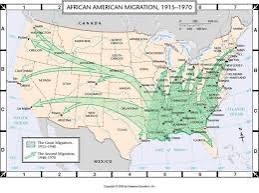
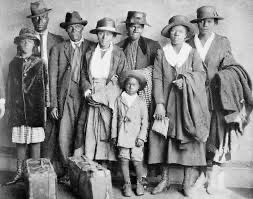
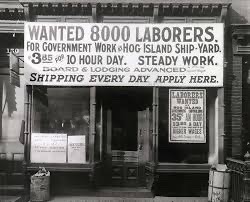
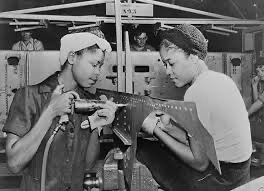



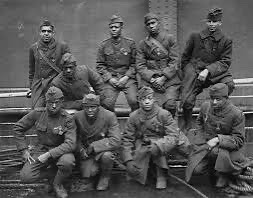
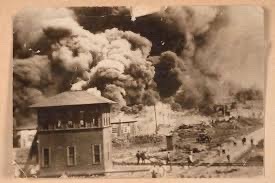

1 note
·
View note